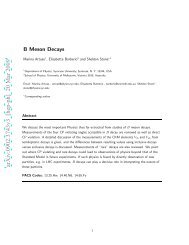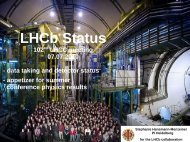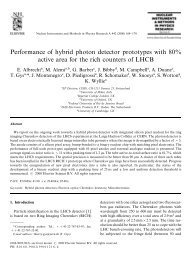Electronics of LHCb calorimeter monitoring system - LHCb - Cern
Electronics of LHCb calorimeter monitoring system - LHCb - Cern
Electronics of LHCb calorimeter monitoring system - LHCb - Cern
You also want an ePaper? Increase the reach of your titles
YUMPU automatically turns print PDFs into web optimized ePapers that Google loves.
• Memory <strong>of</strong> the scanning algorithm FPGA with 64<br />
patterns <strong>of</strong> the output trigger signals allows perform<br />
all needed sequences for LED flashing.<br />
• The <strong>calorimeter</strong> <strong>monitoring</strong> <strong>system</strong> is linked to the<br />
<strong>LHCb</strong> ECS <strong>system</strong> by the SPECS serial bus<br />
(developed in LAL).<br />
Typical LED and PMT stability plots are shown on Figure<br />
9 and 10. Each point corresponds <strong>of</strong> the mean value <strong>of</strong> PM<br />
amplitude for 200 events<br />
Figure 9: Typical LED stability plot (time in hour)<br />
Figure 10: Typical LED stability plot (time in hour)<br />
Time scan technique is used for a correct time adjustment<br />
<strong>of</strong> the LED <strong>monitoring</strong> <strong>system</strong> and checking an inter-crate<br />
synchronization. For doing the detector time alignment the<br />
automated process has been implemented to scan the LED<br />
delay from PVSS project and collect data by DAQ (increment<br />
step by step the 1 ns delay <strong>of</strong> the LEDTSB). Precision and<br />
stability <strong>of</strong> the signal arriving time measurement [3] is about<br />
<strong>of</strong> 0.3 ns. Figure 11 illustrates the LED signal scanned shapes<br />
<strong>of</strong> the HCAL module [4] and Figure 12 shows the time and<br />
amplitude distributions <strong>of</strong> the PMT response on LED flash.<br />
Figure 11: Typical LED integrated signal scanned shapes<br />
<strong>of</strong> the HCAL module (time in ns)<br />
Figure 12: Time and amplitude distributions <strong>of</strong> the PMT<br />
response on LED for HCAL<br />
V. ECS SOFTWARE FOR CONTROL OF THE LED<br />
MONITORING SYSTEM<br />
<strong>LHCb</strong>'s Experiment Control System is in charge <strong>of</strong> the<br />
configuration, control and <strong>monitoring</strong> <strong>of</strong> all the components<br />
<strong>of</strong> the online <strong>system</strong>. This includes all devices in the areas <strong>of</strong>:<br />
data acquisition, detector control (ex slow controls), trigger,<br />
timing and the interaction with the outside world.<br />
The control framework <strong>of</strong> the <strong>LHCb</strong> is based on a SCADA<br />
(Supervisory Control and Data Acquisition) <strong>system</strong> called<br />
PVSSII. Which provides the following main components and<br />
tools:<br />
• A run time database<br />
• Archiving<br />
• Alarm Generation & Handling<br />
• A Graphical Editor<br />
• A Scripting Language<br />
• A Graphical Parameterization tool













